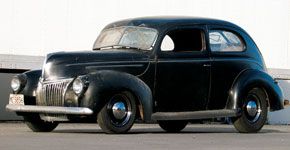
Recently we bought a '39 Ford deluxe sedan. We bought the car not necessarily because we're Fordophiles; we bought it because everybody else is. Buying a car based on its popularity may fly in the face of individual expression, but we have our reasons-mainly the fact that companies make parts only if there's a demand for them. And last time we checked, people owning Fords outnumbered everything else 10 to one.
Since parts are available and the cars are simple, just about anyone can economically restore and modify a Ford suspension to sit right and handle and ride well. In fact, it's entirely possible to do the job in increments that take the car off the road for only days at a time. Also consider that it's also possible to do the job without even using a torch or welder. Sound too good to be true? Well it isn't. We did just that in the space of a weekend (not counting paint).
We did it by using many of the parts developed by pioneer hot rod vendors Pete & Jake's. While there's nothing secret or new about these parts (they've been around for years), the way we used them on this car is relatively novel.
When we decided to build the car, we elected to not split the wishbone, or the link that mounts the front axle to the chassis. Our reasons were threefold: since we're keeping the stock transmission, we didn't need to; to split the 'bone requires both a torch and welder, which we know some of you don't have; and splitting the 'bone also causes the front suspension to bind ever so slightly as the suspension articulates (only a significant issue with tube axles, though). Anyway, we also admit that we liked the prospect of leaving the frame intact, and splitting the wishbone requires cutting the X-member apart. And that's a dirty chore at best.
If there's a problem with not splitting the 'bone, it's due to the distance between the axle perches, or the two locations where the wishbone meets the axle. The '37-41 axle and their wishbones have a 38 1/2-inch perch width, whereas the P&J Super Bell dropped axle-and all '28-'36 axles and most other dropped axles for that matter-has a 36 1/2-inch perch width.
While we could've split the 'bone to fit the narrower axle (which you very well may elect to do), it would've required a torch, a welder, and a wishbone split kit. Instead, we decided to use a narrower '35-36 wishbone, which works from '37-40, but not on a '41.
Whereas the 4-inch-dropped '32-36-style axle lowers the car by a smidge more than 2 inches (the stock axle sports almost a 2-inch drop already), the '35-36 wishbone actually raises the car by almost 3/4-inch. Disheartening? Yes, and in itself almost reason enough to split the '37-41 'bone; however, we got around that with a POSIES reversed-eye spring.
While we could've lowered the car by the same amount the earlier wishbone raised the car by having a local spring shop reverse the spring eyes, it's an inelegant and somewhat ineffective solution. After 70 years of service, any spring is, well, sprung. As springs fatigue, they lose their spring rate and their ability to properly support the car. Sure fatigued springs make a car sit lower, but at the expense of shackle geometry and ride and handling quality. Not good.
Instead, we opted for one of POSIES reversed-eye Super Slide springs. Not only does it maintain the proper spring rate and geometry, it also lowers the car far more than simply reversing the stock springs' eyes. The Super Slide name designates a series of plastic pucks between the leaves that reduce friction, and that reduced friction ultimately benefits ride quality. As you'll see in the photos, it's almost an entirely different spring than the one we removed. While it certainly cost more than a shop would've charged to reverse the eyes on our stock spring, most of the savings would've disappeared once the sandblaster and painter got done with the decrepit stock unit.
Of the many ways one can modify these suspensions, we admit we chose a rather quirky one. On the other hand, it served our purposes well. Other than a grinder, a drill, a saw, and some hand tools, our way doesn't require specialized tools or technical expertise (which is another way to say it's hard for even a rank amateur to screw up this job). If planned right, there's no reason a job like this shouldn't take more than a well-planned holiday weekend. Like we mentioned, we did it in about the same time.
Of all the reasons we favor our method, it's because it preserves Ford's transverse-leaf suspension, a classic design unique to Ford with its own brand of charm. As this shows, it responds well to modifications, and when modified correctly, it handles and rides far better than you'd think.